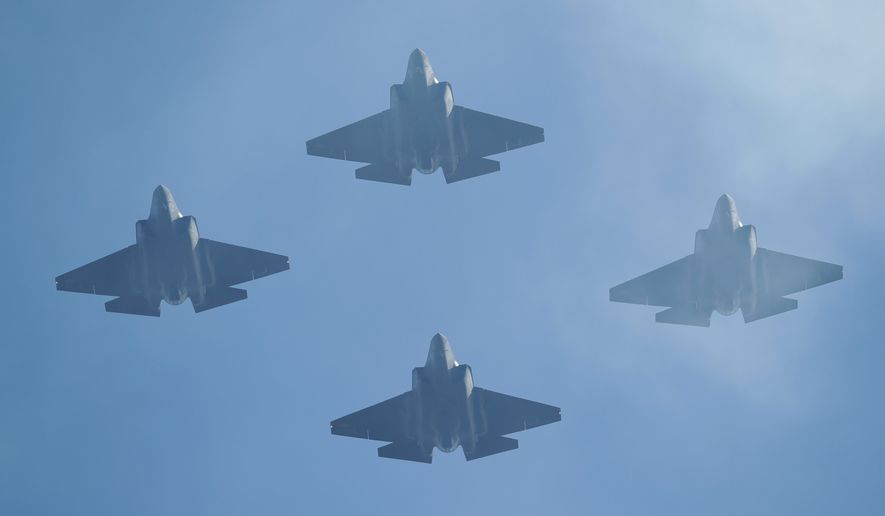Beijing’s expanding military poses a “significant threat” to the United States and the Pentagon is not ready for a conflict with China, according to a new report by the Government Accountability Office.
“Today, China has transformed what was an obsolete military into one that can challenge the U.S. military across the spectrum of conventional and unconventional capabilities,” the GAO said in a report made public this week.
Key weaknesses identified by the congressional watchdog agency include military readiness shortfalls, force mobility problems and supply chain issues needed for new F-35 warplanes.
“Potential adversaries, including China, now contest all domains,” the GAO survey found. “From fiscal years 2017 through 2019, U.S. military readiness increased in the ground domain and declined in the sea domain, while readiness ratings in the space, air and cyber domains were mixed.”
Other problems identified by GAO include vulnerabilities in weapons systems that can be exploited by Chinese cyberattacks, Navy crew fatigue and attack submarine operating problems.
The Defense Department “has struggled to ensure its weapon systems can withstand cyberattacks and should take steps to incorporate cybersecurity requirements into contracts,” the report said.
China’s growing arsenal of space weapons — missiles, robot satellites, lasers and cyber capabilities — also could cripple U.S. military operations in a future conflict.
“China is developing capabilities that threaten [the Defense Department’s] satellite communications systems,” the report said, adding that Beijing is building arms for large-scale anti-satellite strikes using novel physical, cyber and electronic warfare means.
The Pentagon has analyzed ways to replace existing vulnerable space systems but “concluded that it needs more information to select the next satellite communications architecture,” the report said.
A sailor shortage
The GAO said the Navy suffers from a shortage of manpower.
“Crew shortfalls contribute to sailor fatigue and safety issues, including two fatal Navy ship collisions in the Pacific Ocean in 2017,” the report said. “With Navy ships under-crewed by 15% on average in 2020, the Navy will be challenged to fully crew the fleet needed to counter advanced adversaries.”
The Navy also was faulted for not having robust capabilities for repairing ships during wartime. The service is in the early stages of figuring out how to repair ships damaged in a major conflict.
“Without designated leadership, the Navy may be hindered in its efforts to address sustainment challenges,” the GAO said.
Any conflict with China would involve large-scale attacks on Navy ships from the People’s Liberation Army’s large arsenal of anti-ship missiles.
China has deployed several types of ballistic missiles capable of targeting moving ships at sea, including DF-26 missiles that the GAO says can reach target ships 932 miles from Chinese coasts.
The Navy’s asymmetric warfare advantage of having a powerful attack submarine fleet also has been hampered by readiness issues. The report said the Navy lost over 10,000 operating days for attack submarines from 2008 through 2018. During the delays “these key assets provided no operational capability,” the GAO said.
The Chinese military is also working on advanced artificial intelligence systems for warfare.
“China views artificial intelligence (AI) as critical to its future military and industrial power and is pursuing plans to be the global leader in AI by 2030,” the report.
Challenges for China
Despite the findings, the report noted that China is also facing challenges, including its own military weaknesses.
The Defense Intelligence Agency has stated that China, while a large developing nation, “still faces multiple complex security challenges including several regional territorial disputes,” the report said.
China’s decades-long military buildup of both conventional and nuclear forces has not achieved Beijing’s goal of creating a world-class armed forces by 2049. According to the report, the Pentagon “risks not achieving the new strategy’s goals because it has not taken key actions — such as identifying processes and procedures to integrate [electromagnetic spectrum] operations across the department, reforming governance structures, and clearly assigning leadership for strategy implementation.”
Regarding electronic warfare that is likely to be a major feature of a potential U.S.-China war, the GAO said the Pentagon needs better oversight over electronic warfare operations to ensure the superiority of China and control the battlefield.
Electronic warfare involves offensive and defensive measures to disrupt enemy weapons and communications and protect U.S. systems.
GAO said in an earlier report that despite strategy reports produced in 2013, 2017 and 2020, the Pentagon has failed to assign senior leaders with authority and resources to implement effective strategies.
The report concluded that China’s growing economic, diplomatic, military and technological power and a willingness to employ those powers pose a significant long-term threat.
The Pentagon needs to better prepare for competition and combat with China by increasing combat capabilities and enhancing conventional deterrence of a conflict.
“Going forward, key policy considerations include ensuring that the Defense Department is prepared to maintain supply chains, gather intelligence, and responsibly leverage emerging space, cyber, and AI technologies in response to potential threats,” the report said.
A Pentagon spokesman did not immediately respond to an email request for comment.
• Bill Gertz can be reached at bgertz@washingtontimes.com.




Please read our comment policy before commenting.